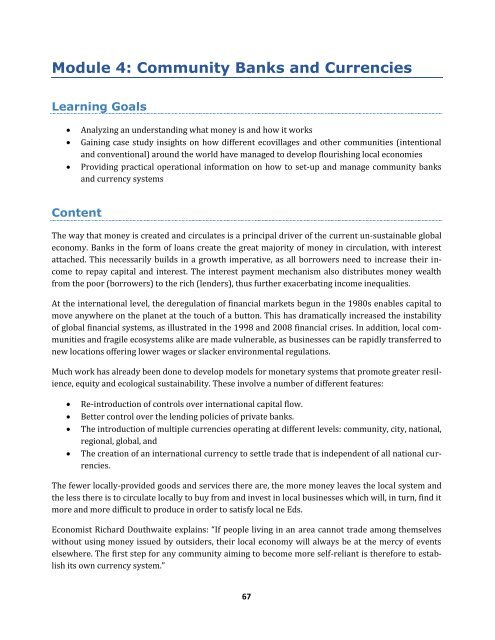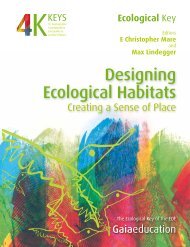EDE Curriculum 2012.pdf - Gaia Education
EDE Curriculum 2012.pdf - Gaia Education
EDE Curriculum 2012.pdf - Gaia Education
Create successful ePaper yourself
Turn your PDF publications into a flip-book with our unique Google optimized e-Paper software.
Module 4: Community Banks and Currencies<br />
Learning Goals<br />
� Analyzing an understanding what money is and how it works<br />
� Gaining case study insights on how different ecovillages and other communities (intentional<br />
and conventional) around the world have managed to develop flourishing local economies<br />
� Providing practical operational information on how to set-up and manage community banks<br />
and currency systems<br />
Content<br />
The way that money is created and circulates is a principal driver of the current un-sustainable global<br />
economy. Banks in the form of loans create the great majority of money in circulation, with interest<br />
attached. This necessarily builds in a growth imperative, as all borrowers need to increase their income<br />
to repay capital and interest. The interest payment mechanism also distributes money wealth<br />
from the poor (borrowers) to the rich (lenders), thus further exacerbating income inequalities.<br />
At the international level, the deregulation of financial markets begun in the 1980s enables capital to<br />
move anywhere on the planet at the touch of a button. This has dramatically increased the instability<br />
of global financial systems, as illustrated in the 1998 and 2008 financial crises. In addition, local communities<br />
and fragile ecosystems alike are made vulnerable, as businesses can be rapidly transferred to<br />
new locations offering lower wages or slacker environmental regulations.<br />
Much work has already been done to develop models for monetary systems that promote greater resilience,<br />
equity and ecological sustainability. These involve a number of different features:<br />
� Re-introduction of controls over international capital flow.<br />
� Better control over the lending policies of private banks.<br />
� The introduction of multiple currencies operating at different levels: community, city, national,<br />
regional, global, and<br />
� The creation of an international currency to settle trade that is independent of all national currencies.<br />
The fewer locally-provided goods and services there are, the more money leaves the local system and<br />
the less there is to circulate locally to buy from and invest in local businesses which will, in turn, find it<br />
more and more difficult to produce in order to satisfy local ne Eds.<br />
Economist Richard Douthwaite explains: “If people living in an area cannot trade among themselves<br />
without using money issued by outsiders, their local economy will always be at the mercy of events<br />
elsewhere. The first step for any community aiming to become more self-reliant is therefore to establish<br />
its own currency system.”<br />
67







